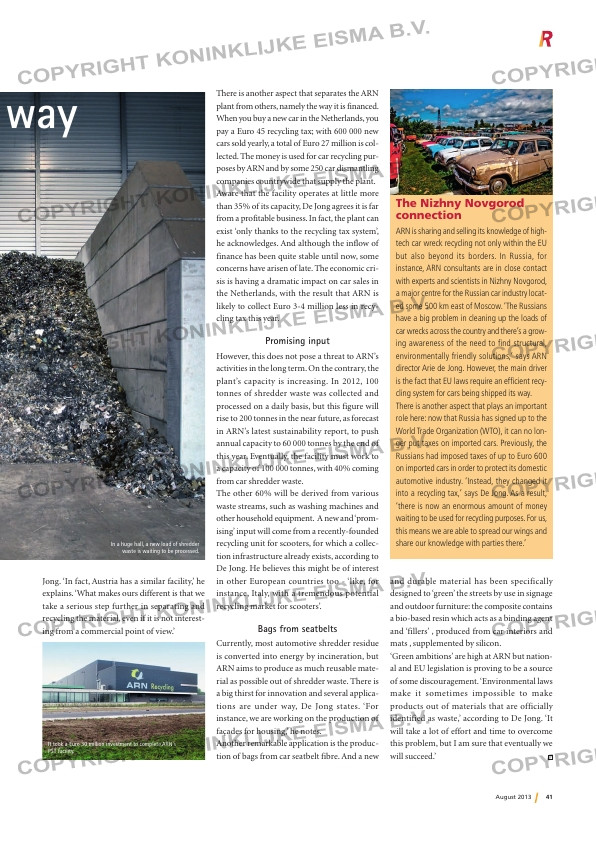Page 41 from: August 2013

41August 2013
Jong. ‘In fact, Austria has a similar facility,’ he
explains. ‘What makes ours different is that we
take a serious step further in separating and
recycling the material, even if it is not interest-
ing from a commercial point of view.’
There is another aspect that separates the ARN
plant from others, namely the way it is financed.
When you buy a new car in the Netherlands, you
pay a Euro 45 recycling tax; with 600 000 new
cars sold yearly, a total of Euro 27 million is col-
lected. The money is used for car recycling pur-
poses by ARN and by some 250 car dismantling
companies countrywide that supply the plant.
Aware that the facility operates at little more
than 35% of its capacity, De Jong agrees it is far
from a profitable business. In fact, the plant can
exist ‘only thanks to the recycling tax system’,
he acknowledges. And although the inflow of
finance has been quite stable until now, some
concerns have arisen of late. The economic cri-
sis is having a dramatic impact on car sales in
the Netherlands, with the result that ARN is
likely to collect Euro 3-4 million less in recy-
cling tax this year.
Promising input
However, this does not pose a threat to ARN’s
activities in the long term. On the contrary, the
plant’s capacity is increasing. In 2012, 100
tonnes of shredder waste was collected and
processed on a daily basis, but this figure will
rise to 200 tonnes in the near future, as forecast
in ARN’s latest sustainability report, to push
annual capacity to 60 000 tonnes by the end of
this year. Eventually, the facility must work to
a capacity of 100 000 tonnes, with 40% coming
from car shredder waste.
The other 60% will be derived from various
waste streams, such as washing machines and
other household equipment. A new and ‘prom-
ising’ input will come from a recently-founded
recycling unit for scooters, for which a collec-
tion infrastructure already exists, according to
De Jong. He believes this might be of interest
in other European countries too – ‘like, for
instance, Italy, with a tremendous potential
recycling market for scooters’.
Bags from seatbelts
Currently, most automotive shredder residue
is converted into energy by incineration, but
ARN aims to produce as much reusable mate-
rial as possible out of shredder waste. There is
a big thirst for innovation and several applica-
tions are under way, De Jong states. ‘For
instance, we are working on the production of
façades for housing,’ he notes.
Another remarkable application is the produc-
tion of bags from car seatbelt fibre. And a new
and durable material has been specifically
designed to ‘green’ the streets by use in signage
and outdoor furniture: the composite contains
a bio-based resin which acts as a binding agent
and ‘fillers’ , produced from car interiors and
mats , supplemented by silicon.
‘Green ambitions’ are high at ARN but nation-
al and EU legislation is proving to be a source
of some discouragement. ‘Environmental laws
make it sometimes impossible to make
products out of materials that are officially
identified as waste,’ according to De Jong. ‘It
will take a lot of effort and time to overcome
this problem, but I am sure that eventually we
will succeed.’
The Nizhny Novgorod
connection
ARN is sharing and selling its knowledge of high-
tech car wreck recycling not only within the EU
but also beyond its borders. In Russia, for
instance, ARN consultants are in close contact
with experts and scientists in Nizhny Novgorod,
a major centre for the Russian car industry locat-
ed some 500 km east of Moscow. ‘The Russians
have a big problem in cleaning up the loads of
car wrecks across the country and there’s a grow-
ing awareness of the need to find structural,
environmentally friendly solutions,’ says ARN
director Arie de Jong. However, the main driver
is the fact that EU laws require an efficient recy-
cling system for cars being shipped its way.
There is another aspect that plays an important
role here: now that Russia has signed up to the
World Trade Organization (WTO), it can no lon-
ger put taxes on imported cars. Previously, the
Russians had imposed taxes of up to Euro 600
on imported cars in order to protect its domestic
automotive industry. ‘Instead, they changed it
into a recycling tax,’ says De Jong. As a result,
‘there is now an enormous amount of money
waiting to be used for recycling purposes. For us,
this means we are able to spread our wings and
share our knowledge with parties there.’
Treating car wrecks the Dutch way
In a huge hall, a new load of shredder
waste is waiting to be processed.
It took a Euro 30 million investment to complete ARN’s
PST facility.
RI-6_ARN.indd 41 01-08-13 13:15



